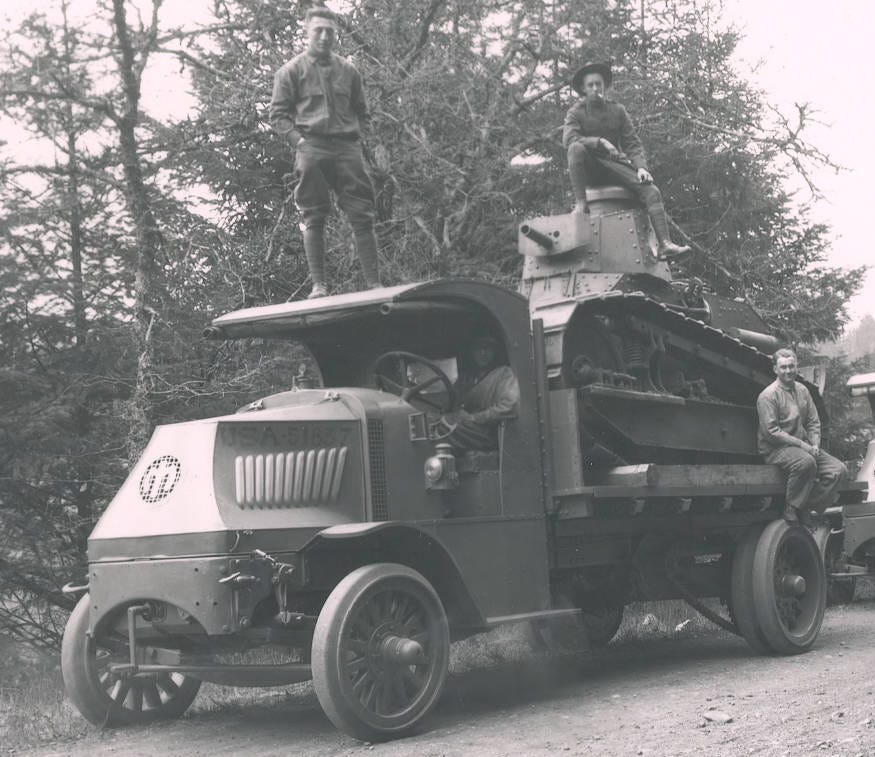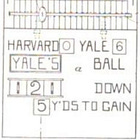A Hole Big Enough To Drive A Mack Truck Through
I don't know if line coaches still refer to offensive lines opening holes big enough to drive a Mack truck through or to players who are built like Mack trucks, but they did in my day. Both phrases were compliments since Mack trucks were workhorses, best known for their vocational trucks used for cement mixers, dump and refuse trucks, or hauling heavy highway loads.
So it is fitting that the 1918 Draper-Maynard (aka D&M) sporting goods catalog has an iconic cover featuring a Mack truck. With the country in the midst of WWI, companies that were not directly involved in the war effort featured war-related imagery in their marketing; D&M's image of a U.S. Army Mack AC being one of them. As you will see, D&M was tangentially involved in supplying war goods, though it was not their focus.
Mack ACs, as pictured on the cover, came in 3 1/2, 5 1/2, and 7 1/2-ton versions. Mack supplied 4,500 ACs to the U.S. Army during the war and 2,000 to the British Army. The Brits took a particular liking to the AC's toughness and durability, nicknaming it the "Bulldog." The doughboys picked up on the nickname, leading Mack to adopt the bulldog as its corporate logo in 1921. So, the next time you notice a bulldog hood ornament seemingly pulling a Mack truck down the road, you'll know how it got there.

Like many old school sporting goods companies, Draper Maynard started in the leather industry, when two brothers opened a shop in Plymouth, New Hampshire, making buckskin gloves in 1840. The company's entry into sports came when baseball player, Arthur Irwin, broke several fingers during the 1882 season and created a homemade glove to protect his fingers. He soon met with the D&M folks and had them create a glove to his specs. While catchers and first basemen wore gloves by then, D&M's Irwin Glove normalized gloves for other positions, helping the company dominate the baseball glove industry for several decades. (For more information about D&M or if you are looking for the best information regarding old-time football equipment, check out Chris Hornung's Antique Football.)
Irwin proved to be an inventive guy. When later working at Penn, he created football's first scoreboard and the remote game simulations that were popular before commercial radio.
During WWI, football and other sports were popular activities at military camps for intramural and external competition, so D&M and others proudly supplied their products to the armed services, and touted the fact in their catalog.
Much of the 1918-1919 catalog presents D&M football and other sports products like any other year, though they describe their olive-drab pants as "Bomb Proof," which is certainly a call to the boys in Europe.
D&M presents their helmets in a civilian manner, without reference to the military. Football helmets of the time did not have hard shells. They were soft leather with felt pads sewn between the interior and exterior leather. They were akin to putting a thin baseball glove on your head.
However, football helmets were not the only helmets D&M manufactured in 1918. In the days of open cockpits, pilots wore leather helmets to keep warm and for protection. Several football helmets shown above and the model 23H aviation helmet with the cross straps foretold the direction of football helmets of the 1920s.
D&M's 1918-1919 catalogs had two other nods to the military. First, they offered travel products for officers that kept them neat and trim under dire circumstances. Second, they offered boxing gloves, used in training camps for fun and to prepare for future battles with the Hun.
D&M and nearly everyone else feasted during the Roaring Twenties, but famine followed in the 1930s. D&M closed its doors in 1937. Its name and product designs went to P. Goldsmith and Sons of Cincinnati, which also bought Crawford McGregor & Canby Co. They branded themselves as McGregor Goldsmith in the 1950s before dropping the Goldsmith name. That concern was bought and sold multiple times over the decades, making it difficult to find any trace of Draper-Maynard today. Of course, if you are into such things, Plymouth State University has a fun collection of Draper- Maynard catalogs and other items online here.
Mack Truck continues driving down America's roads, though it has been owned by Sweden's Volvo Group since 2001.
Football Archaeology is reader-supported. Click here to buy one of my books, donate, or otherwise support the site.
Coming soon, the history of the early forward pass.










The offensive line cliche of “opening holes big enough to drive a _____ through” goes back to at least the 1890s and might be worth its own tidbit post if you haven’t done one on that topic before. I spent a little bit of time on that last year and found these two examples.
A November 25, 1899 Minneapolis Tribune article on a local high school football game that said one school’s left tackle “opened up holes…through which a train of cars could have passed.”
After Texas beat Texas A&M on Thanksgiving Day in 1907, the Fort Worth Telegram said that UT’s offensive tackles Bob Ramsdell and L.H. Feldhake “made holes in the [A&M] line thru which wagons could have driven.” I don’t know if Ramsdell ever saw that article but he would have appreciated that line because when he was a teenager his family had moved by wagon from Salado, Texas to the town of Alvin 200 miles away, a trip which took them two weeks. Ramsdell’s brother Fred Ramsdell was a Walter Camp All-American halfback at Penn in 1910.